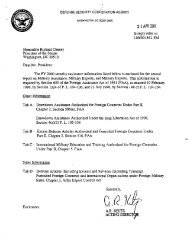memorandum of justification concerning human ... - Just the Facts
memorandum of justification concerning human ... - Just the Facts
memorandum of justification concerning human ... - Just the Facts
Create successful ePaper yourself
Turn your PDF publications into a flip-book with our unique Google optimized e-Paper software.
UNCLASSIFIED<br />
- 79 -<br />
document presented by Afro-Colombian organizations at <strong>the</strong> National Assembly <strong>of</strong><br />
Community Councils and Ethnic Organizations from Afro-Colombian, Raizal, and<br />
Palenquera Communities in San Andrés de Tumaco on December 17-18, 2008. The<br />
Directorate, toge<strong>the</strong>r with Accion Social‘s Sub-Unit on <strong>the</strong> Displaced, has met with<br />
AFRODES three times to fur<strong>the</strong>r develop its proposal and design a methodology for<br />
moving it forward.<br />
As addressed in <strong>the</strong> section above on civilian outreach to indigenous communities,<br />
<strong>the</strong> Colombian government continued to implement <strong>the</strong> ―Integrated Plan to Support<br />
Indigenous Communities with High Vulnerability and Risk for Disappearance.‖ During<br />
<strong>the</strong> certification period, <strong>the</strong> government continued to implement nine plans, begun in<br />
2006, to benefit Afro-Colombians in Chocó and Cauca. In <strong>the</strong> department <strong>of</strong> Nariño, six<br />
plans in Olaya Herrera, Santa Bárbara de Iscuandé, La Tola, El Charco, Francisco<br />
Pizarro, and Tumaco focused on streng<strong>the</strong>ning prevention and protection mechanisms for<br />
public authorities, family structures and community psycho-social assistance, and<br />
alternative development opportunities. As <strong>of</strong> May 2009, <strong>the</strong>se plans were 85 percent<br />
completed. In Cauca, <strong>the</strong> government is executing two plans in Bolivar and Mercedes,<br />
and on La Sierra and El Tambo, which are focused on streng<strong>the</strong>ning protection and<br />
prevention mechanisms with respect to <strong>human</strong> rights, and increasing citizen participation,<br />
including by streng<strong>the</strong>ning Afro-Colombian organizations in <strong>the</strong> region. One additional<br />
plan in Cauca, developed in 2009, is being executed in Balboa and Patía, focused on<br />
implementing measures to streng<strong>the</strong>n <strong>the</strong> social fabric <strong>of</strong> Afro-Colombian communities<br />
and mitigating <strong>the</strong> impact <strong>of</strong> violence on those communities.<br />
Training on Rights <strong>of</strong> Afro-Colombians<br />
During <strong>the</strong> certification period, <strong>the</strong> Colombian government conducted 10<br />
workshops on <strong>the</strong> rights <strong>of</strong> Afro-Colombian communities for 855 local government<br />
representatives and o<strong>the</strong>rs throughout <strong>the</strong> country:<br />
Armenia (Quindío) – July 2008: Conference on <strong>the</strong> rights <strong>of</strong> Afro-<br />
Colombians; 100 participants from district and municipal <strong>of</strong>fices in Armenia<br />
Acandi (Choco) – July 2008: Conference on rights <strong>of</strong> Afro-Colombians<br />
with a focus on prior consult; 150 participants from <strong>the</strong> municipal<br />
administration and community councils in Acandi<br />
Riosucio (Choco) – September 2008: Meeting on Afro-Colombian<br />
legislation; 120 participants from community councils in <strong>the</strong> Atrato zone<br />
Villavicencio (Meta) – November 2008: Workshop on <strong>the</strong> rights <strong>of</strong> Afro-<br />
Colombians; 130 participants from <strong>the</strong> municipal administration in<br />
Villavicencio<br />
UNCLASSIFIED



